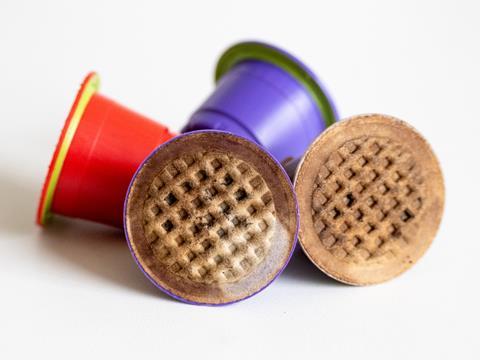
TIPA and ATI have unveiled a ‘first-of-its-kind’ fully compostable lid for coffee capsules, set to align with upcoming compostability legislation and improve barrier protection, sealing properties, protection against material migration, and more.
Reportedly, the patent-protected lidding material is compatible with all compostable coffee filling lines, capsules, and variations, including the Nespresso system. It aims to serve as an environmentally friendly addition to Nespresso’s existing compostable capsules in France and Switzerland, with TIPA asserting that 29,000 plastic coffee capsules are currently sent to landfill every minute across the world.
The plant-based lid has received OK Biobased’s highest accreditation of four stars – signifying a minimum carbon content of 80%, with the carbon derived from renewable raw materials – and has been certified by its official laboratories.
It is intended to resolve previous issues faced by manufacturers with sustainability-minded capsule lids, including poor sealing properties, delamination, inconsistent or non-existent flow, a lack of barrier protection, and materials migrating into the beverage itself. TIPA also claims that the lidding material can be optimized alongside the coffee grind for high extraction quality.
At end-of-life, the lid is designed to be disposable in food waste bins as per the EN 13432 protocol. This falls in line with the UK Plastics Pact’s goal of ensuring all coffee capsules are made from compostable materials, as well as the Packaging and Packaging Waste Regulation’s mandate that coffee capsules should be compostable in countries where they can be collected in food waste bins.
TIPA’s high-barrier laminate is said to compost into nutrient-rich soil in the space of a few months when placed in a compost bin. The company cites a study by Wageningen University and Research suggesting that compostable capsules are the most sustainable choice for single-serve coffee units, alongside existing research in which consumers rated compostability as the most environmentally friendly disposal method for packaging in 2022.
“Whilst compostable coffee capsules have been on the market for several years, the market is yet to develop effective lids to complement the capsules,” explains TIPA CEO and co-founder Daphna Nissenbaum. “Within this collaboration with ATI, TIPA has delivered a superior solution to the coffee market. The compostable coffee capsule lids ensure that there is a fully compostable and circular solution for coffee lovers, whilst giving brands eco-friendly solutions developed by experts.”
Mark Klep, CEO and founder of ATI, continued: “Over the last thirteen years we have been pioneering the developments of laboratory-certified, durable and fully compostable packaging solutions. Our latest achievement of a patented coffee capsule lidding material developed with OTR and WVTR, in partnership with TIPA, is a milestone for sustainability in the coffee industry.”
The new lid is now available for purchase in the UK, Europe, and the USA.
Earlier this year, a study indicated that coffee pods emit less greenhouse gases throughout their life cycle than filter, French press, and instant coffees.
Since then, ALPLA’s Blue Circle brand revealed its recyclable, biodegradable coffee capsules – designed as a tasteless, migration-free alternative to single-use pods – and Solinatra’s plant-based capsules have been certified as industrially compostable by TÜV Austria.
As a founding member of the UK’s Compostable Coalition, which aims to produce completely compostable packaging that leaves zero residue, TIPA aspires to produce compostable alternatives for all food and fashion products. Its recent contributions include its conversion of rice waste into a recyclable and home-compostable tray for fruits, vegetables, baked goods, and hot food.
If you liked this article, you might also enjoy:
The L’Oréal approach to packaging sustainability
What steps is Apple taking to make its packaging more sustainable?
How did Brazil achieve its 100% aluminium can recycling rate – and can it be replicated in the EU?
Experts have their say on the EU’s Packaging and Packaging Waste Directive revisions
















No comments yet